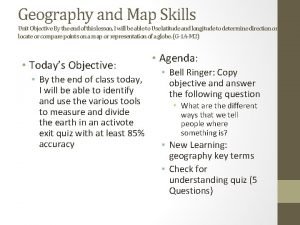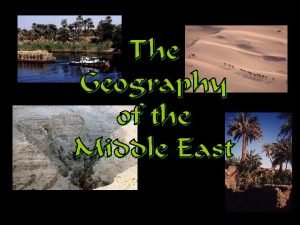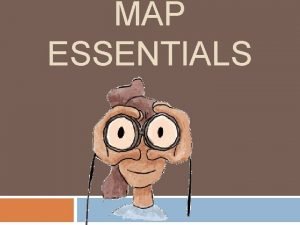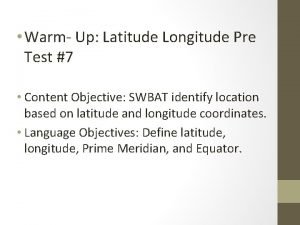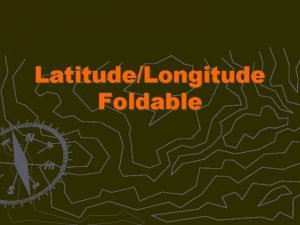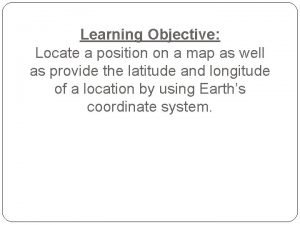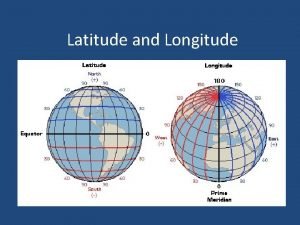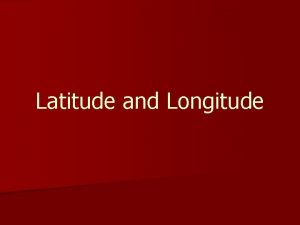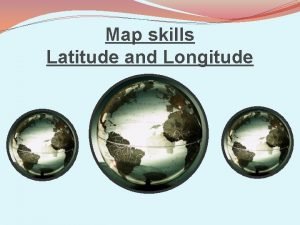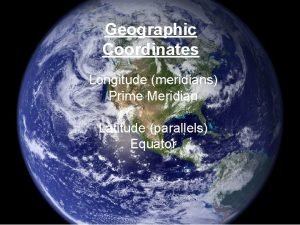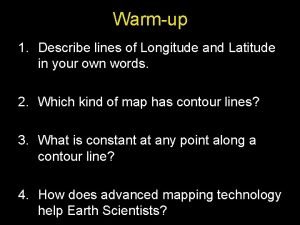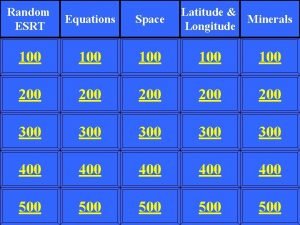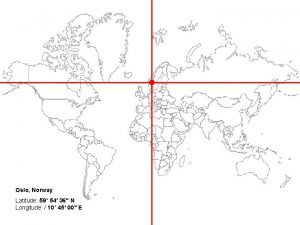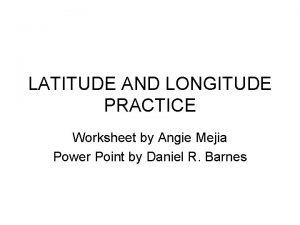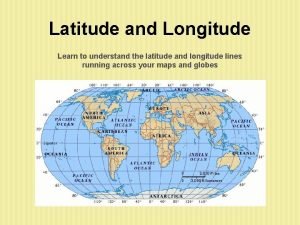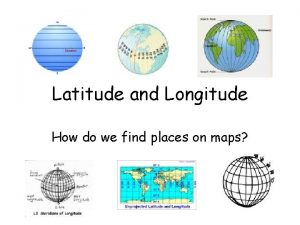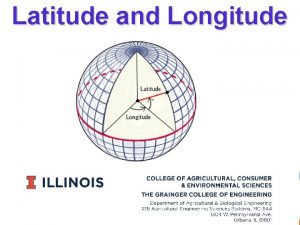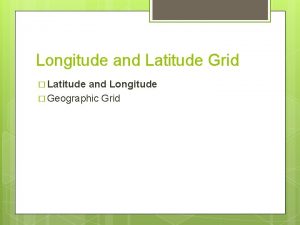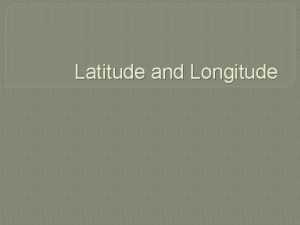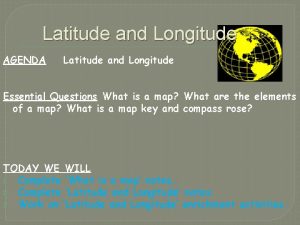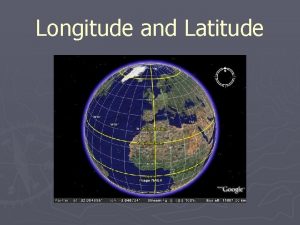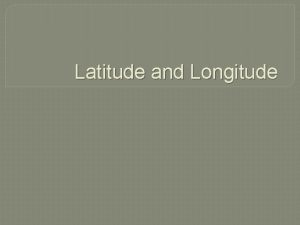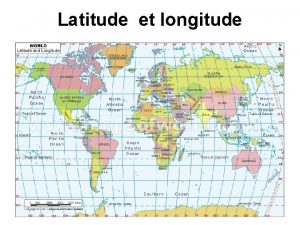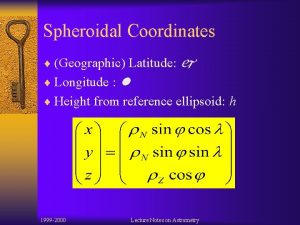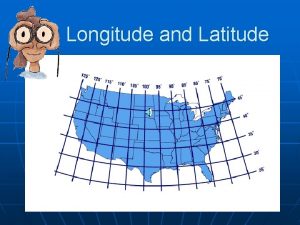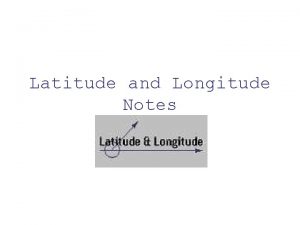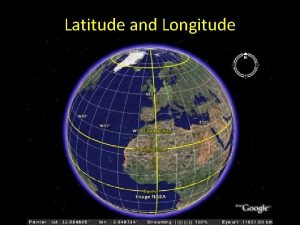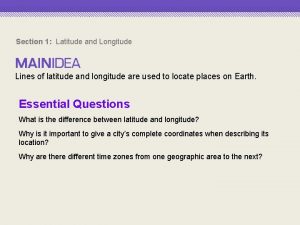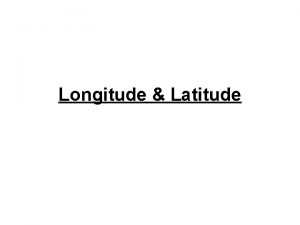Map Projections Geographic coordinates Latitude Longitude Which is


























- Slides: 26

Map Projections

Geographic coordinates ► Latitude ► Longitude ► Which is which? ► What are the lines called? ► How to you write them? ► Converting to decimal degrees ► Norths?

Magnetic declination

Why projections? ► Map projections are attempts to portray the surface of the earth or a portion of the earth on a flat surface. Some distortions of conformality, distance, direction, scale, and area always result from this process. Some projections minimize distortions in some of these properties at the expense of maximizing errors in others. Some projections are attempts to only moderately distort all of these properties. § Conformality ► When the scale of a map at any point on the map is the same in any direction, the projection is conformal. Meridians (lines of longitude) and parallels (lines of latitude) intersect at right angles. Shape is preserved locally on conformal maps. § Distance ► A map is equidistant when it portrays distances from the center of the projection to any other place on the map. § Direction ► A map preserves direction when azimuths (angles from a point on a line to another point) are portrayed correctly in all directions. § Scale ► Scale is the relationship between a distance portrayed on a map and the same distance on the Earth. § Area When a map portrays areas over the entire map so that all mapped areas have the same proportional relationship to the areas on the Earth that they represent, the map is an equal-area map. (Peter H. Dana 1999, http: //www. colorado. edu/geography/gcraft/notes/mapproj_f. html) ►

Why should I care? ►It says something about who you are, dude…

Three Projections of the US (Peter H. Dana 1999, http: //www. colorado. edu/geography/gcraft/notes/mapproj_f. html)

Cylindrical projections (Peter H. Dana 1999, http: //www. colorado. edu/geography/gcraft/notes/mapproj_f. html)

Secant Cylindrical projection (Peter H. Dana 1999, http: //www. colorado. edu/geography/gcraft/notes/mapproj_f. html)

Transverse Cylindrical (Peter H. Dana 1999, http: //www. colorado. edu/geography/gcraft/notes/mapproj_f. html)

Oblique Cylindrical (Peter H. Dana 1999, http: //www. colorado. edu/geography/gcraft/notes/mapproj_f. html)

Conical (Peter H. Dana 1999, http: //www. colorado. edu/geography/gcraft/notes/mapproj_f. html)

Secant Conical (Peter H. Dana 1999, http: //www. colorado. edu/geography/gcraft/notes/mapproj_f. html)

Planar Tangent (Peter H. Dana 1999, http: //www. colorado. edu/geography/gcraft/notes/mapproj_f. html)

Planar Secant (Peter H. Dana 1999, http: //www. colorado. edu/geography/gcraft/notes/mapproj_f. html)

Universal Transverse Mercator ► ► The Universal Transverse Mercator system is a group of 60 cylindrical, secant projections that divide up the surface of the earth into numbered 6 degree-wide longitudinal strips called “zones, ” extending from 80 degrees South latitude to 84 degrees North latitude. See: https: //www. uwgb. edu/dutchs/Field. Methods/UTMSystem. htm They are conformal, meaning that angles and shapes are preserved, while scale and area are not, and can be significantly distorted. Distortion increases away from the central meridian of the projection. UTM zone characters designate 8 degree zones extending north and south from the equator. The projection is secant in each zone by a scale factor of 0. 996 along the central meridian. The tangent lines are about 180 km apart. Many national grid systems are based on the Transverse Mercator projection § § § NATO countries use one unified systems Warsaw Pact countries used a slightly different system Yet other countries, i. e. , Mexico, use similar systems

Universal Transverse Mercator

UTM Zones

Each UTM Zone ► Eastings are measured from the central meridian (with a 500 km false easting to insure positive coordinates). Northings are measured from the equator (with a 10, 000 km false northing for positions south of the equator).

Calculating UTMs from USGS map

Public Land Survey System ► Originally proposed by Thomas Jefferson ► Started shortly after the Revolution ► Covers Public Lands § Including lands given to the national government by the 13 colonies § lands that have since become private § And lands acquired from the Indians and foreign governments ► Administered by the BLM ► Actually composed of 37 separate surveys, each with its own principal meridian and baseline ► Numerous errors, but they are retained ► Early surveys in Indiana and Ohio were irregular

PLSS Principal Meridians and Baselines

PLSS Basic Organization ► Divides land into 6 -mile square townships § Using numbered Township and Range lines ► Townships are divided into 36 square mile sections § By using section lines ► Regular sections are typically numbered in a particular order ► Sections can be divided into quarter sections, quarter-quarter sections, or irregular lots

PLSS

PLSS-Louisiana ► In Louisiana, parcels of land known as arpent sections or French arpent land grants also pre-date the PLSS, but are treated as PLSS sections. § An arpent is a French measurement of approximately 192 feet, and a square arpent (also referred to as an arpent) is about 0. 84 acres. ► ► ► French arpent land divisions are long narrow parcels of land usually found along the navigable streams of southern Louisiana, and also found along major waterways in other areas. This system of land subdivision was begun by French settlers in the 1700 s, according to typical French practice at the time and was continued by both the Spanish and by the American government after the acquisition of the Louisiana Purchase. A typical French arpent land division is 2 to 4 arpents wide along the river by 40 to 60 arpents deep, while the Spanish arpent land divisions tend to be 6 to 8 arpents wide by 40 arpents deep. This method of land division provided each land-owner with river frontage as well as land suitable for cultivation and habitation. These areas are given numbers just like standard sections, although the section numbers frequently exceed the normal upper limit of 36.

State Plane Coordinate System ► Popular in some areas with governments because of its accuracy ► It can be as much as four times more accurate than UTM projection ► BUT, it achieves this accuracy by using small zones, which cause problems in mapping large areas ► It’s a plane system with associated coordinates ► Designed to have a maximum error of 1 in 10, 000. ► Zone boundaries generally follow political boundaries not lines of latitude and longitude (like the UTM zones)

State Plane Coordinate System
 Picture
Picture Middle east natural resources
Middle east natural resources World map with longitude and latitude lines
World map with longitude and latitude lines Latitude and longitude test
Latitude and longitude test Northern hemisphere latitude
Northern hemisphere latitude North south east west globe
North south east west globe Usa latitude map
Usa latitude map Utah longitude and latitude
Utah longitude and latitude Is the equator a line of latitude
Is the equator a line of latitude Equator color
Equator color Philippine map with latitude and longitude
Philippine map with latitude and longitude Map skills using latitude and longitude
Map skills using latitude and longitude Geographic parallels
Geographic parallels Describe longitude and latitude
Describe longitude and latitude Highest point netherlands
Highest point netherlands Prime meridian
Prime meridian Random longitude and latitude
Random longitude and latitude Oslo longitude and latitude
Oslo longitude and latitude Longitude shape
Longitude shape Longitude and latitude practice worksheet
Longitude and latitude practice worksheet 40 degrees north latitude
40 degrees north latitude How to read latitude and longitude
How to read latitude and longitude What do lines of latitude and longitude combine to make
What do lines of latitude and longitude combine to make Who invented latitude and longitude grid system
Who invented latitude and longitude grid system Krakatoa latitude and longitude
Krakatoa latitude and longitude Latitude and longitude of india
Latitude and longitude of india Lines of latitude run from
Lines of latitude run from
